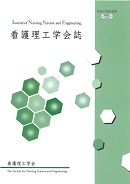Volume 3, Issue 2
Journal of Nursing Science and Engineering
Displaying 1-8 of 8 articles from this issue
- |<
- <
- 1
- >
- >|
Prolusion
-
2016Volume 3Issue 2 Pages 65
Published: July 25, 2016
Released on J-STAGE: February 28, 2018
Download PDF (109K)
perspective
-
2016Volume 3Issue 2 Pages 66-72
Published: July 25, 2016
Released on J-STAGE: February 28, 2018
Download PDF (510K)
Original Articles
-
2016Volume 3Issue 2 Pages 73-85
Published: July 25, 2016
Released on J-STAGE: February 28, 2018
Download PDF (1454K) -
2016Volume 3Issue 2 Pages 86-92
Published: July 25, 2016
Released on J-STAGE: February 28, 2018
Download PDF (203K) -
2016Volume 3Issue 2 Pages 93-100
Published: July 25, 2016
Released on J-STAGE: February 28, 2018
Download PDF (479K) -
2016Volume 3Issue 2 Pages 101-108
Published: July 25, 2016
Released on J-STAGE: February 28, 2018
Download PDF (467K) -
2016Volume 3Issue 2 Pages 109-117
Published: July 25, 2016
Released on J-STAGE: February 28, 2018
Download PDF (938K)
Practical Report
-
2016Volume 3Issue 2 Pages 118-122
Published: July 25, 2016
Released on J-STAGE: February 28, 2018
Download PDF (424K)
- |<
- <
- 1
- >
- >|
